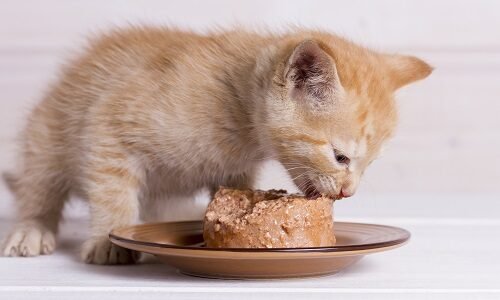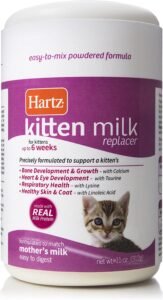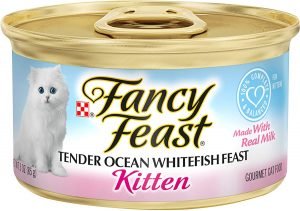To set kitten owners at ease, we have created Guidelines for Introducing Wet Cat Food to Kittens. Knowing when to start, what to introduce and how to go about it will make the process easier for kitten owners, and at the same time, ensure kittens get the best care and nutrition.
When Should Wet Kitten Food Be Introduced?

Newborn kittens are born toothless as this is when they are suckling milk from their mothers. Their first baby teeth appear when they are about 2-4 weeks of age. These deciduous milk teeth fall out when they are 3-4 months old, and the kitten’s permanent adult teeth then appear.
The stage kittens are at with their teeth determines what stage they are at with the type of food they are ready to eat. A kitten up to 5 weeks old ought to be nursing or being bottle fed with a kitten formula.
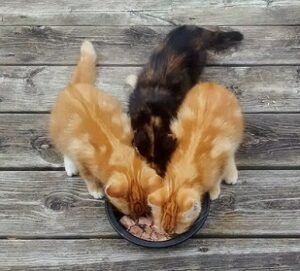 Around 5 weeks, the kitten’s premolars will begin to emerge. This indicates that she is likely ready to start attempting some meaty foods. Follow the kitten’s lead to decide the right age to wean. If you see any decline in the kitten’s health (Indicators of a healthy kitten- see point below) or energy during this process, step back to bottle feeding.
Around 5 weeks, the kitten’s premolars will begin to emerge. This indicates that she is likely ready to start attempting some meaty foods. Follow the kitten’s lead to decide the right age to wean. If you see any decline in the kitten’s health (Indicators of a healthy kitten- see point below) or energy during this process, step back to bottle feeding.
What Kitten Food Should Kittens Start Out With?
Kitten food is very different to adult cat food. Kitten food is for energetic growing kittens. It is higher in calories, protein and fat. Adult cat food should not be fed to kittens.
Wet kitten food is the healthiest choice as it is not only easy for kittens to eat and digest, but it has a higher moisture content to dry kitten food. Hydration is important with kittens, especially if they have been fully weaned from their mother’s milk.
Some kittens may prefer dry kitten kibble. The balance of proteins, fats and other essential nutrients will be similar with a quality dry kitten food as it is with a quality wet kitten food. Offering a kitten the choice will determine which they prefer.
Introducing Wet Cat Food to Kittens
The key here is not to rush the kitten into eating wet kitten food. They will need time to adjust to the new flavors and proteins.
You may begin by introducing a small teaspoon of wet food mixed with the milk formula. Some kitten owners find using their finger, or tongue depressor, helps.
As the kitten becomes more comfortable eating wet food, you can then increase the ratio so that there is more wet food present in each feeding.
10 Best Kitten Foods of 2022
When they are ready, you may present the food on a shallow plate. It may take a few days for your kitten to get used to the idea of eating off a plate.
The process of weaning kittens off their mother’s milk (or kitten formula), is a gradual process. Whilst you are introducing wet cat food to kittens, it is still necessary to allow them to continue feeding on milk (not cow’s milk), as this ensures that your kitten is getting all the calories and nutrition he needs during this gradual transition.
Is Cows Milk OK for Kittens?
Never give kittens cows’ milk! Cows’ milk is for calves not kittens- it will cause nutrition and digestive problems in kittens.
Monitor The Kitten Throughout the Weaning Process
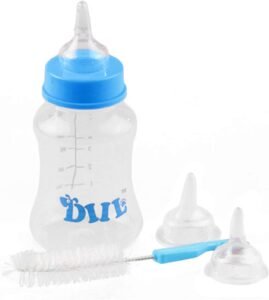 By observing kittens as they are being weaned you will notice if their condition changes. If their
By observing kittens as they are being weaned you will notice if their condition changes. If their
weight dips or steadies, you’ll need to supplement with a bottle, try a different method of feeding, or scale back to kitten formula.
Fully Weaned Diet
Most kittens are completely weaned by 6-8 weeks of age and should be fed according to their needs following the recommendations of the food manufacturer as a guide.
Once they are confidently eating solid food on their own, supplementary feeding can cease. Be sure you are feeding high quality food formulated for kittens. Foods that are not giving your kitten a 100% balanced diet will slow your kitten’s growth.
Not having the right balance of protein and carbohydrate; or food that are loaded up with grain fillers, may result in health problems such as immune issues and digestive upsets.
The Importance of Hydration when Introducing Wet Cat Food to Kittens
Keep your kitten hydrated. Always ensure water is on offer in a shallow bowl. This is especially so for kittens being fed solely dry kitten kibble.
Can Kittens Be Fed Dry Food?
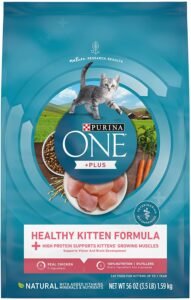 The short answer is yes. There are obvious advantages of introducing wet cat food to kittens (as explained earlier), however, a quality dry kitten kibble will also cover all the nutritional requirements of kittens.
The short answer is yes. There are obvious advantages of introducing wet cat food to kittens (as explained earlier), however, a quality dry kitten kibble will also cover all the nutritional requirements of kittens.
In the beginning, mixing kitten formula with the dry kibble will soften it, making it easier for kittens to eat.
Some kittens will prefer dry food over wet. Experiment with your kitten to see what he likes. Also try different flavors and textures. You will soon discover the food that your kitten finds irresistible!
What to Look for in a Quality Commercial Kitten Food
 Seek high protein products using real meat, not meat by-products.
Seek high protein products using real meat, not meat by-products.- Avoid grain fillers- wheat, soy, corn.
- Avoid excessive vegetable carbohydrates- potatoes
- Minimal fish (tuna, salmon)
- Avoid dairy and egg ingredients.
- Avoid artificial colors, flavors and preservatives.
- Seek products with recipes that include vitamins and minerals
3 Signs Your Kitten is Healthy
There are numerous reasons why your kitten may be sick. These can include hairballs, foreign objects in the digestive system, intestinal parasites, allergies, food poisoning, feline parvovirus, and inflammatory bowl disease.
Look for the following healthy kitten signs:
- Body condition– you should simply be able to feel, but not see, your kitten’s ribs.
- Nose– your kitten’s nose is usually damp and soft to the touch. Their nostrils should be free of discharge or crusting.
- Mouth– teeth ought to be white with no excess tartar, with black or pale pink gums.
- Faeces are solid– vomiting and diarrhea are concerning.
10 Best Kitten Foods of 2022
Introducing Wet Cat Food to Kittens- Final Thoughts
What your kitten eats will build the foundations for his health over his lifetime. There is no hurry with introducing wet cat food to kittens. Take your time and watch your kitten flourish!
A Final Word
Cat Food Advisor is privately owned. We do not accept money, samples, gifts, or other incentives in exchange for special consideration in preparing our reviews.
However, we do receive a referral fee from online retailers, like Chewy or Amazon (at no extra cost to you) when readers click over to their websites from ours. This helps cover the cost of operation of our free blog. Thanks for your support.
For more information, please visit our Disclaimer and Disclosure page.

